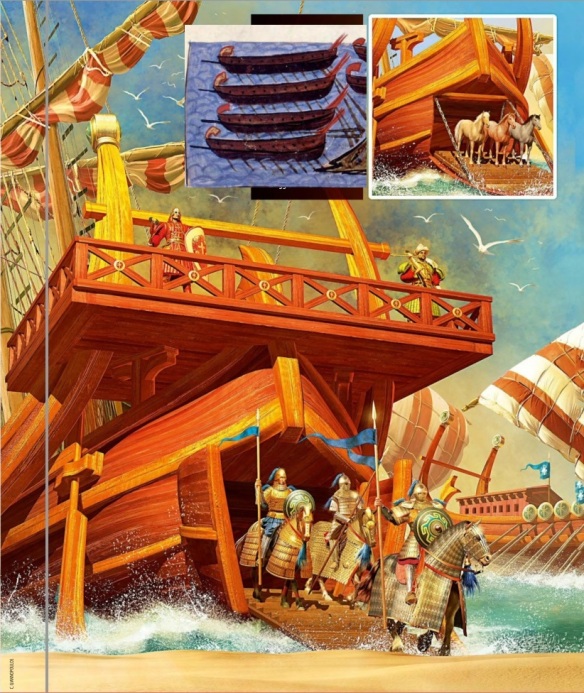Two possible variants of amphibious technique employed by Byzantine for landing in Crete
In the first case (large illustration), the bow of the ship opened to let out a ramp of wood that allowed to disembark cataphracts and their horses.
In the second case (smaller upper left), the bow has a drawbridge, supported by iron chains. These boats had a flat keel and rounded hull were really floating stalls, thus was their ability to stow large quantities of animals and forage.
Other types included the supply and carrier ships like the pamphylos, which was `like a baggage-train, which will carry all the equipment of the soldiers, so that the dromons are not burdened with it; and especially in time of battle, when there is need of a small supply of weapons or other materiel, [these] undertake the distribution’.
The horse-transport units of the Byzantine fleet had been equipped with a climax since at least the early tenth century, which was a ramp used for the loading and unloading of the horses from the ship’s gunwales, either from the stern or usually from the bow. This term is mentioned in the De Ceremoniis for the Cretan expeditions of 911, 949 and 960/126 and reveals the necessary modifications to the ships when they had to carry horses, such as hatches not just to the sides but also on the decks, leading down into the holds, while further modifications would have been engineered in the hulls of the ships concerning the stabling of the horses. According to Pryor, the khelandia were indeed specialised horse transports, able to carry between twelve and twenty horses. But these must have been built differently from dromons when it comes to the dimensions of the ship’s beam, which would have been much wider to accommodate both the lower bank oarsmen and the horses. A significant structural difference between the tenth-century Byzantine transport ships and their Italian counterparts in the twelfth century was that the latter placed both banks of oarsmen on the upper deck, thus making more room for the horses in the ship’s hull.
